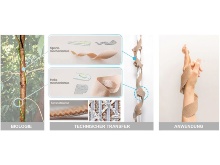Natural materials, such as in plant and bone organs, adapt to their surroundings with functionally graded underlying structures. Advances in extrusion-based 4D-printing have enabled the manufacture of bio-inspired systems with varying properties and self-shaping behaviour. However, tailoring the internal composition of such systems relies on specialised knowledge, as most computer-aided design (CAD) applications are based on a modelling paradigm that considers objects as surfaces or solids with no geometrical definition of the interior structure. We propose that engineered materials with differentiated and heterogeneous mesostructures can achieve nature-inspired functionality. We present a design approach for tailoring the internal topology of 4D-printed material systems, using intuitive geometric descriptions from existing CAD workflows. We introduce a material programming framework for assigning and tuning material properties such as elasticity and shape change with varying magnitudes and anisotropies throughout a volume. Our method translates the desired properties into an assembly of functional patterns for fabrication via anisotropic material deposition. To demonstrate this framework, we show several types of material behaviour, including self-shaping double curvature and embedded passive cooling. Finally, we produce a prototype of a wearable assistive device that highlights the integration of multiple functions. Through design and material programming, the resulting 4D-printed material systems underline how nature-inspired mesostructured material networks can be physically encoded with custom-designed behaviours, shape changes and functionalities.
- Multifunctional Mesostructures: Design and Material Programming for 4D-printing
- Bio-Inspired Motion Mechanisms: Computation Design and Material Programming of Self-Adjusting 4D-Printed Wearable Systems


